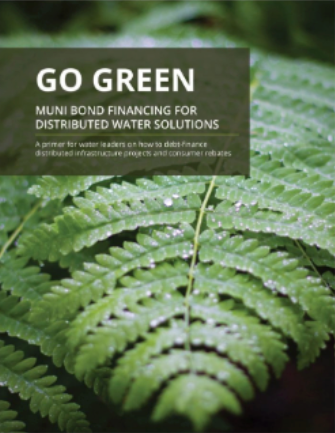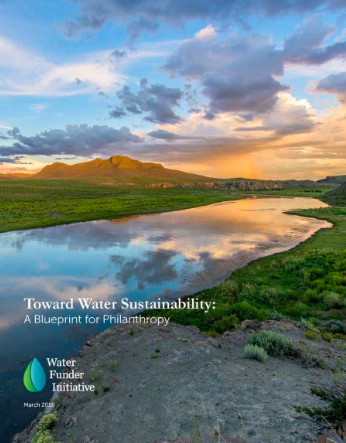Funding Incentive Programs
 Funding Incentive Programs
Funding Incentive Programs
For years, water agencies were not sure whether they could access their capital dollars for consumer incentive programs. This meant that funding for consumer rebates and other financial incentives were constrained by the competing needs of utility operating budgets. Click here to see the results of WaterNow’s 2019 survey of local elected officials and water managers, asking: Is the ability to pay for or finance consumer rebate programs a limiting factor in your community? To date, this constraint has kept these programs at only a small fraction of overall budgets.
But as a result of a 2-year WaterNow campaign, in May 2018 the Governmental Accounting Standards Board (GASB) issued new guidance making it clear that municipal bond proceeds can be used to fund localized water infrastructure.
WaterNow's Go Green primer explores why the new GASB guidance is a game changer, and how to redeploy your capital dollars to distributed solutions. Looking for a quick explanation of this policy change? Watch this short explanatory video with Ed Harrington on what GASB 62 is and how it works.
In sum, utilities can either fund consumer incentive programs out of their operating or capital budgets, and utility rates and fees play an important role in generating the revenue required to pay for these program.
Toward Water Sustainability: A Blueprint for Philanthropy
 Toward Water Sustainability: A Blueprint for Philanthropy
Toward Water Sustainability: A Blueprint for Philanthropy
The Water Funder Initiative (WFI) is a collaborative effort to identify and activate promising water solutions through strategic philanthropic investments in the United States, starting in the American West, where the scarcity and reliability of clean water are urgent issues. WFI has developed a blueprint for philanthropy to advance sustainable water management at a scale never before attempted in the water field.
Click the link below to download a copy of the blueprint.
WIFIA Letter of Interest Checklist
 WIFIA Letter of Interest Checklist
WIFIA Letter of Interest Checklist
The WIFIA program is intended to accelerate investment in the nation’s water infrastructure by providing long-term, low-cost supplemental loans for regionally and nationally significant projects. The WIFIA program was established by the Water Infrastructure Finance and Innovation Act of 2014. Prospective borrowers must first submit a letter of interest and then, if invited by the Environmental Protection Agency, will submit a full loan application.
As of October 2019, EPA is in the process of updating the WIFIA application materials. Check back soon for those new materials!
WIFIA Application
 WIFIA Application
WIFIA Application
The WIFIA program is intended to accelerate investment in the nation’s water infrastructure by providing long-term, low-cost supplemental loans for regionally and nationally significant projects. The WIFIA program was established by the Water Infrastructure Finance and Innovation Act of 2014. Prospective borrowers must first submit a letter of interest and then, if invited by the Environmental Protection Agency, will submit a full loan application.
As of October 2019, EPA is in the process of updating the WIFIA application materials. Check back soon for those new materials!
WIFIA Application Review Process
 WIFIA Application Review Process
WIFIA Application Review Process
The WIFIA program is intended to accelerate investment in the nation’s water infrastructure by providing long-term, low-cost supplemental loans for regionally and nationally significant projects. The WIFIA program was established by the Water Infrastructure Finance and Innovation Act of 2014. Prospective borrowers must first submit a letter of interest and then, if invited by the Environmental Protection Agency, will submit a full loan application.
As of October 2019, EPA is in the process of updating the WIFIA application materials. Check back soon for those new materials!
WIFIA Program Benefits
 WIFIA Program Benefits
WIFIA Program Benefits
The WIFIA program is intended to accelerate investment in the nation’s water infrastructure by providing long-term, low-cost supplemental loans for regionally and nationally significant projects. The WIFIA program was established by the Water Infrastructure Finance and Innovation Act of 2014.
Click the link below to download a copy of the Environmental Protection Agency's WIFIA program benefits.
WIFIA Program Summary
 WIFIA Program Summary
WIFIA Program Summary
The WIFIA program is intended to accelerate investment in the nation’s water infrastructure by providing long-term, low-cost supplemental loans for regionally and nationally significant projects. The WIFIA program was established by the Water Infrastructure Finance and Innovation Act of 2014.
Click the link below to download a copy of the Environmental Protection Agency's WIFIA program summary.
Green Project Reserve Eligibility Guidance
 Green Project Reserve Eligibility Guidance
Green Project Reserve Eligibility Guidance
According to the Environmental Protection Agency, Congress' intent in enacting the Green Project Reserve (GPR) is to direct State investment practices in the water sector to guide funding toward projects that utilize green or soft-path practices to complement and augment hard or gray infrastructure, adopt practices that reduce the environmental footprint of water and wastewater treatment, collection, and distribution, help utilities adapt to climate change, enhance water and energy conservation, adopt more sustainable solutions to wet weather flows, and promote innovative approaches to water management problems. Additionally, EPA expects that green projects will help the water sector improve the quality of water services without putting additional strain on the energy grid, and by reducing the volume of water lost every year.
Click the link below to download a copy of EPA's guidance on GPR eligibility.
Overview: State Revolving Funds
 Overview: State Revolving Funds
Overview: State Revolving Funds
The Clean Water State Revolving Fund (CWSRF) program is a federal-state partnership that provides communities a permanent, independent source of low-cost financing for a wide range of water quality infrastructure projects. The Drinking Water State Revolving Fund (DWSRF) program is a federal-state partnership to help ensure safe drinking water. Created by the 1996 Amendments to the Safe Drinking Water Act (SDWA) the program provides financial support to water systems and to state safe water programs.
State revolving loan funds can be used to:
control nonpoint sources of pollution
implement water efficiency programs
build decentralized wastewater treatment systems
create green infrastructure projects
protect estuaries
Click here to download a copy of the Environmental Protection Agency's primer on how SRF funds can be used to pay for water efficiency programs
Funding Water Efficiency Through State Revolving Funds
 Funding Water Efficiency Through the State Revolving Fund Programs
Funding Water Efficiency Through the State Revolving Fund Programs
When water demand is inflated by wasteful water use and water loss, water systems and their customers spend more than necessary in capital and operating costs. Water efficiency and reuse also are important for meeting the environmental goals of many states and communities. The number of water efficiency programs has increased dramatically in the last 10 years, and these programs are now found in almost every part of the United States. The Drinking Water State Revolving Fund (DWSRF) and Clean Water State Revolving Fund (CWSRF) programs can be important sources of financial assistance to help states and systems initiate a variety of efficiency measures and programs.
Click the link below to download a copy of the Environmental Protection Agency's primer on how SRF funds can be used to pay for water efficiency programs.
